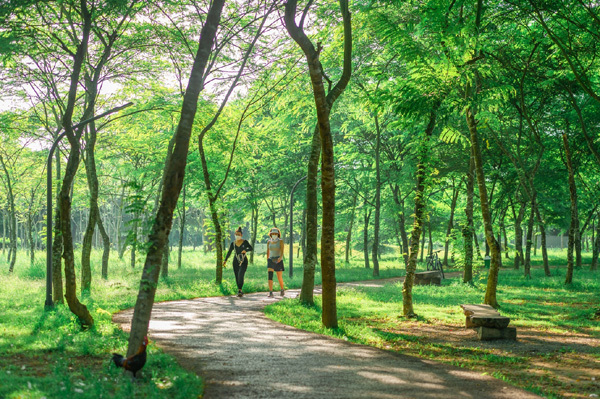 |
| Visitors at Binh Chanh’s history museum. - SGT Photo: Phan Yen Ly |
Despite the high urbanization rate and growing population, Binh Chanh may provide travelers with compelling historical stories and natural sites interesting enough to explore.
A history museum covering 12 hectares should be the first stop of the itinerary. At the museum, visitors can learn more about Vietnam’s last wars through documents, pictures and other exhibits. The museum is also a place which commemorates fallen revolutionary soldiers in the Mau Than campaign in 1968, better known in the West as the Tet Offensive.
Binh Chanh District is replete with other religious sites. Among them is Bat Buu Phat Dai Pagoda whose highlight is a seven-meter-tall Buddha statue. Another religious facility is Vietnam Buddhist Academy which trains monks and nuns in Vietnam.
Not far from Bat Buu Phat Dai lies a century-old incense stick making village. Taking photos with the colorful sticks and watching the process of making incense sticks are what visitors are expected to do in this traditional craft village.
Aside from historical relics and religious sites, Binh Chanh also remains largely a green spot in HCMC. On an acreage of nearly 300 hectares, Le Minh Xuan Forest may be called “a forest in a city,” which is also a green lung of Saigon as well as a source of timber from planted forest. Cycling under the foliage of this vast green should be attractive to many travelers.
Visitors should enjoy herbal massage treatment available in Binh Chanh. Some health spas on the bank of a big lake may earn guests a truly relaxing time.
Eventually, a short food tour around Binh Chanh may wrap up a one-day trip to the suburban district.
Source: SGT

Living in suburbs: growing trend among the well-off
Ten years ago, wealthy people said ‘no’ to properties located far from the center of cities, but more are now moving from the crowded inner city to the suburbs, where they can enjoy fresh air and less noise.

Exploring HCM City tunnels proposed as world heritage
The American War period Vietnamese revolutionary resistance base at the Cu Chi Tunnels, located in the suburbs of present-day HCM City, has been recommended as a UNESCO-recognised world heritage site.